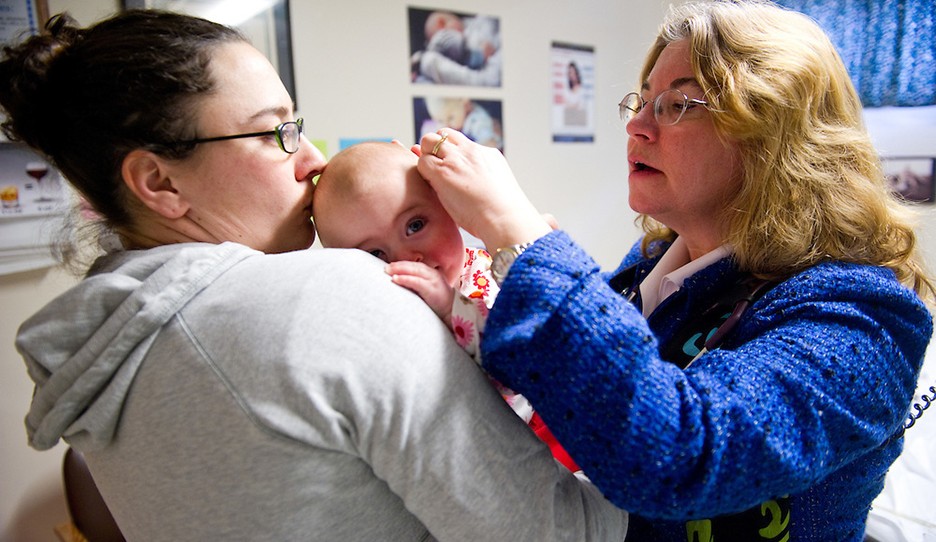Across the United States, more than 120 people have been diagnosed with measles, many of them linked to an outbreak that authorities believe began when an infected person from out of the country visited Disneyland in California in late December.
The dramatic rise of measles cases across the country has affected some states more than others, and the rules for vaccinating vary wildly from coast to coast. Nationally, as of February 6, the Centers for Disease Control and Prevention (CDC) reported 121 people from 17 states in the U.S. developed measles, first linked to the California outbreak.
We talked to Professor Jan K. Carney, MD, MPH, Associate Dean for Public Health at the University of Vermont College of Medicine and director of the UVM Master of Public Health Program, about the recent measles outbreak and the MMR vaccine.
Learning more about the signs and symptoms of measles, and how outbreaks occur with Jan K. Carney, MD, MPH
Q: As a public health expert, what is most troubling about the recent spike in measles cases in the United States?
Dr. Carney: Outbreaks occurring in U.S. communities with large numbers of unvaccinated individuals are largely preventable. Misinformation about the MMR vaccine on the Internet is rampant and consequences of choosing not to vaccinate children causes risks for those children, as well as for other individuals in the community, such as infants too young to get an MMR vaccine or people who can’t be vaccinated because of certain medical conditions. Talking with health care professionals, rather than just relying on the internet, is one way to get trusted and accurate health information. (Here’s a great example from the University of Vermont Medical Center.)

Q: What role do vaccine laws play?
Dr. Carney: They play an essential role in increasing vaccination rates in entire populations to levels that protect all children. School immunization laws, present in every state, are an essential part of our national vaccination policy. All states allow medical exemptions for children with medical conditions that preclude their receiving vaccinations, 48 states allow religious exemptions, and 20 states allow “philosophical” or “personal belief” exemptions.
Allowing personal belief exemptions and making them easy to obtain are related to rising rates of nonmedical vaccination exemptions in the U.S. In one study in the New England Journal of Medicine (NEJM), rates of nonmedical vaccination exemptions were 2.5 times higher in states that permitted philosophical exemptions. A recent article, Is Measles’ Return the ‘New Normal’? in a publication of the U.S. National Library of Medicine, reiterates the importance of measles vaccination.
Despite the ever-present controversy, in light of the current measles outbreak, many states, including Vermont, are taking another look at their state vaccination laws, to ensure a balance between parent choice and public health. In the interim, experts reinforce the importance of parents’ conversations with health professionals in making the best possible decisions for themselves, their families, and their communities.
Q: What percentage of children in Vermont have not received the MMR vaccine?
Dr. Carney: For the Vermont school year 2013-2014, data collected from the Vermont Department of Health shows that of 6,771 kindergarteners, 8.8 percent, or nearly 600 Vermont children are not protected against measles. This figure was much higher (nearly 22%) for private schools. The biggest reason for not being protected was a philosophical exemption to the MMR vaccine.
Vaccination rates vary by school in Vermont (something also reported nationally) creating what some experts call “hot spots” of children vulnerable to measles infection – due to increasing numbers of philosophical exemptions. Nationally, almost 1 in 7 public and private schools have measles vaccination rates below 90 percent, a level recommended by the Centers for Disease Control and Prevention to protect children from infection.
Q: Do you think the recent measles outbreak will encourage more parents – those who previously chose not to vaccinate – to rethink their position?
Dr. Carney: Measles is a huge issue globally, a leading cause of death in young children (145,700 measles deaths in 2013). Why are we seeing more measles in the United States? According to the CDC, since 2000 when measles was declared “eliminated” in the U.S., there have ranged from 37 to 644 cases (2014) each year. This is in part due to more measles in some parts of the world frequented by U.S. travelers, as well as clusters of unvaccinated children in some communities in the United States.
Q: The symptoms of measles include cough, conjunctivitis, red, runny nose, and high fever – which sound like many other viruses. Is there an early tell-tale sign of measles? When is someone most contagious?
Dr. Carney: According to the CDC, three to five days after general symptoms begin, a rash appears, spreading down the body, arms, and legs from the face. (See photo.) Measles virus is very contagious, and people with measles are contagious four days before and four days after their rash begins.
Q: While the mortality rate for measles is relatively low, can you talk about why measles remains so dangerous?
Dr. Carney: CDC reports that 30 percent of people with measles will develop complications such as ear infections or pneumonia. Complications are more common in children younger than age 5 and also in adults older than 20. In young children, about 10 percent of children may have ear infections, sometimes leading to permanent hearing loss. Two of every 1,000 children who get measles die as a result of the infection; 1 of every 1000 infected children develops encephalitis (brain swelling) which may lead to permanent and long-term complications. One of every 20 children infected with measles develops pneumonia, and among children who die, pneumonia is the most common cause.
Before the development and licensure of measles vaccine in 1963, there were more than 500,000 reported measles cases (with actual numbers much higher) and 500 deaths each year. Measles has declined by more than 98 percent since vaccine use became widespread.
Q: How effective is the measles (MMR) vaccination?
Dr. Carney: One dose of MMR vaccine is about 93 percent effective, and two 2 doses are 97 percent effective. Vaccination is the best protection from measles and its complications.
Q: If a parent is struggling over whether to immunize their child against measles, what advice would you give?
Dr. Carney: One of the most extensive studies in the NEJM of the prevention of contagious diseases as a result of vaccination, showed that vaccinations have prevented as many as 106 million cases of infectious diseases. Take a look at the data yourself. Then, and most importantly, have a personal conversation with your primary care provider – ask questions, get evidence-based (scientific) information about the MMR vaccine, and consider that measles can be a serious disease (and yes, we do live in a global society…..). Also, please consider that your decision to vaccinate your child can also protect the health of other children and adults in your community. And remember, as our own Vermont Department of Health reminds us, It’s OK to Ask.





